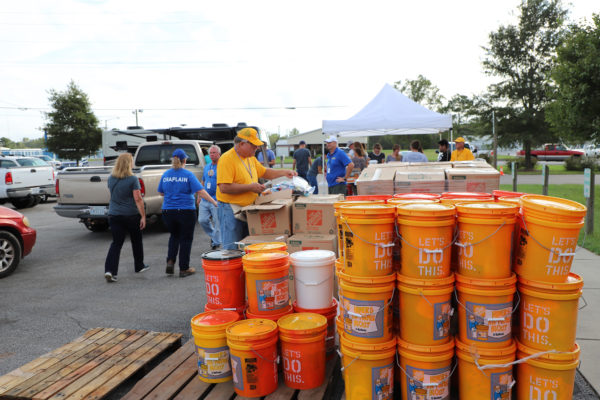Disaster Relief (DR) volunteers from multiple states including Alabama have been deployed to the Carolinas to assist in cleanup efforts following the localized flooding and storm damage wrought by Hurricane Florence.
Alabama Baptist Disaster Relief strategist Mark Wakefield said DR volunteers from several Alabama Baptist associations began arriving in North Carolina Sept. 17. Many faced road closures and downed trees as they traveled. The teams are staging at Southview Baptist Church, Hope Mills, North Carolina.
An Alabama Baptist feeding unit and a shower/laundry unit were in place as of Sept. 19, and several units were doing mudout and chainsaw work in the Fayetteville, North Carolina, area. Assessors were working to identify needs.
“They are telling me there are places that are hard hit not far from here,” Wakefield said.
Alabama Baptist DR teams are getting direction from the Baptist State Convention of North Carolina, Wakefield said. Those operating the feeding unit also are coordinating with North Carolina Emergency Management Agency and American Red Cross to establish a plan for feeding community members.
“We don’t know yet how many meals will be needed,” Wakefield said. “The feeding numbers may go up as people return home.”
Wakefield added that more mudout teams will probably be needed as record floodwaters recede.
More than 30 inches of rain fell in some regions of North and South Carolina as Florence made landfall on Sept. 14 and moved inland. Flooding, power outages and structural damage were widespread and at least 37 deaths were attributed to the storm as of Sept. 20.
Dozens of church buildings also suffered damage along a 150-mile stretch of coastline from Southport, North Carolina, to New Bern, North Carolina, with additional church damage as far inland as Fayetteville, North Carolina, some 140 miles from the Atlantic Ocean.
Serious structural damage to five buildings was reported at the North Carolina Baptist Assembly at Fort Caswell, a camp facility owned by the Baptist State Convention of North Carolina. The Baptist Children’s Homes of North Carolina reported storm damage at two of their campuses, including floodwater at their facility in Kinston, North Carolina, that appeared higher than 2016 flooding which caused $1.5 million in damage following Hurricane Matthew.
The heavy rains and flooding meant some DR efforts had to wait.
“Because the flood disaster is still happening, we have mainly deployed feeding and shower/laundry units,” a Facebook post from South Carolina Baptist DR reported Sept. 19. “There was very little wind/tree damage, so chainsaw units were not needed on a widespread basis. … We will deploy mudout units as soon as flood waters begin receding.”
Floodwaters also cut off access to some cities in need of help.
In Wilmington, North Carolina, 117,000 residents were on “an island” surrounded by floodwater, said Roy Smith, network missionary for the Cape Fear Network of Baptist Churches. Days after Florence made landfall, a feeding unit scheduled for setup at First Baptist Church in Wilmington could not be reached by DR workers, he said, and chainsaw crews could not enter the city.
Members of Wilmington-area Wrightsville Beach Baptist Church removed downed trees from houses and patched roofs with tarps, Smith told Baptist Press. But they were on pace to run out of tarps, with no way of leaving the area to buy more.
Thirty-five miles northwest, Atkinson (N.C.) Baptist Church also found itself on a flood-surrounded island and sheltered stranded travelers in its fellowship hall, Smith said.
The North American Mission Board reported that feeding, chainsaw and mudout units had been deployed in multiple locations to provide meals, essential supplies and trained volunteers to help communities affected by the storm.
Assessment teams continued to work with the Federal Emergency Management Agency (FEMA) and state emergency management agencies along with the American Red Cross and salvation Army to determine where resources would be needed and how best to get those resources in place as floodwaters receded.
As Baptist state conventions partner with the North American Mission Board to mount a disaster relief effort, the response is “a true testimony to the effectiveness of the partnerships throughout all state conventions,” said David Melber, president of Send Relief, NAMB’s crisis response arm.
Disaster relief units from at least nine state conventions had set up feeding units or were preparing to do so for storm victims and emergency workers, according to a report from NAMB, which coordinates multi-state disaster responses.
In New Bern, North Carolina, Temple Baptist Church served as a staging site for Baptist and other DR workers. A feeding unit began Sept. 17 serving 20,000 meals per day, Temple pastor Jim Pennington said. National Guardsmen slept in the church’s sanctuary Sunday night.
As locals recover from storm damage, Pennington said, believers have supplemented their offers of physical help with spiritual encouragement, as in the case of a man whose house was destroyed and partially swept away shortly after he canceled his homeowner’s insurance policy.
Drawing on Jesus’ stilling of a storm in Mark 4, Pennington told the man, “God’s promise to you is that He will get you to the other side of this.” Sobbing, the man responded, “I needed that.”
Despite the destruction, Baptists have much to anticipate as they spread the love of Christ in the Tar Heel State, Pennington said.
“It’s amazing how God is going to use this to reach our community for Christ,” he said. “I have no doubt in my mind whatsoever.” (TAB, BP)






Share with others: